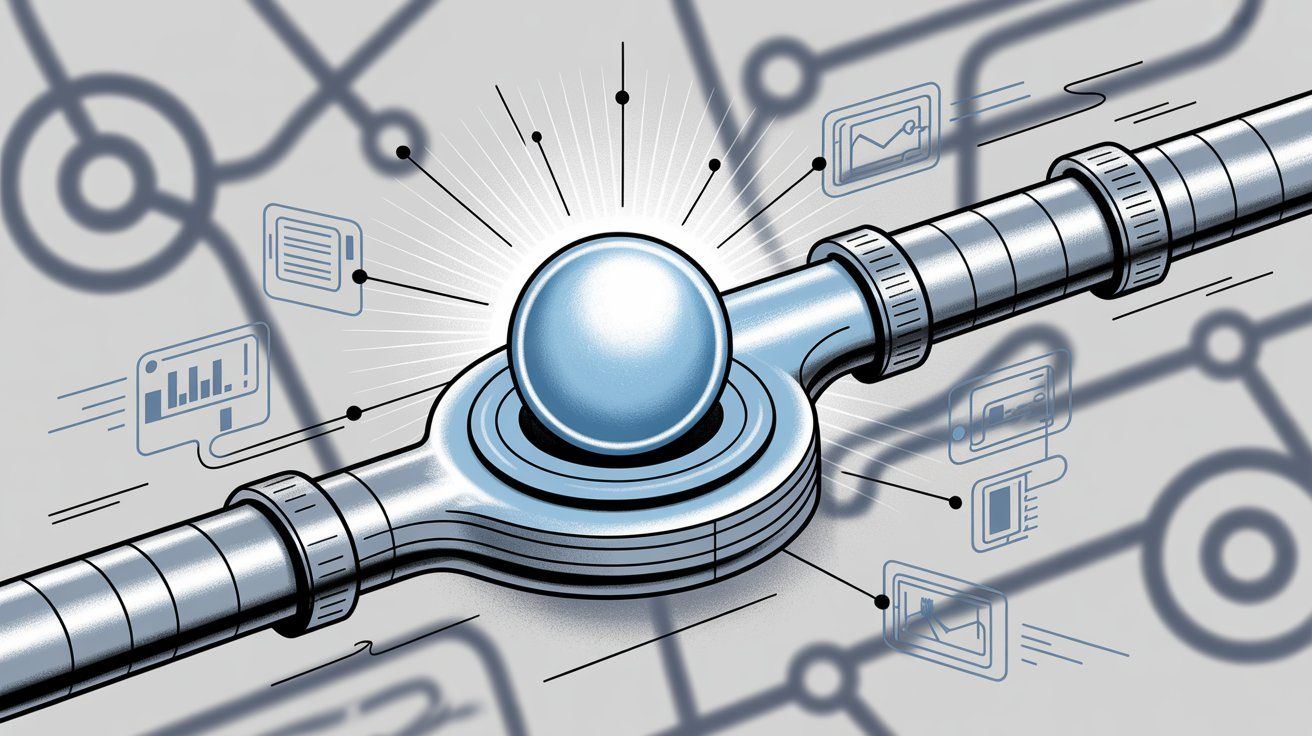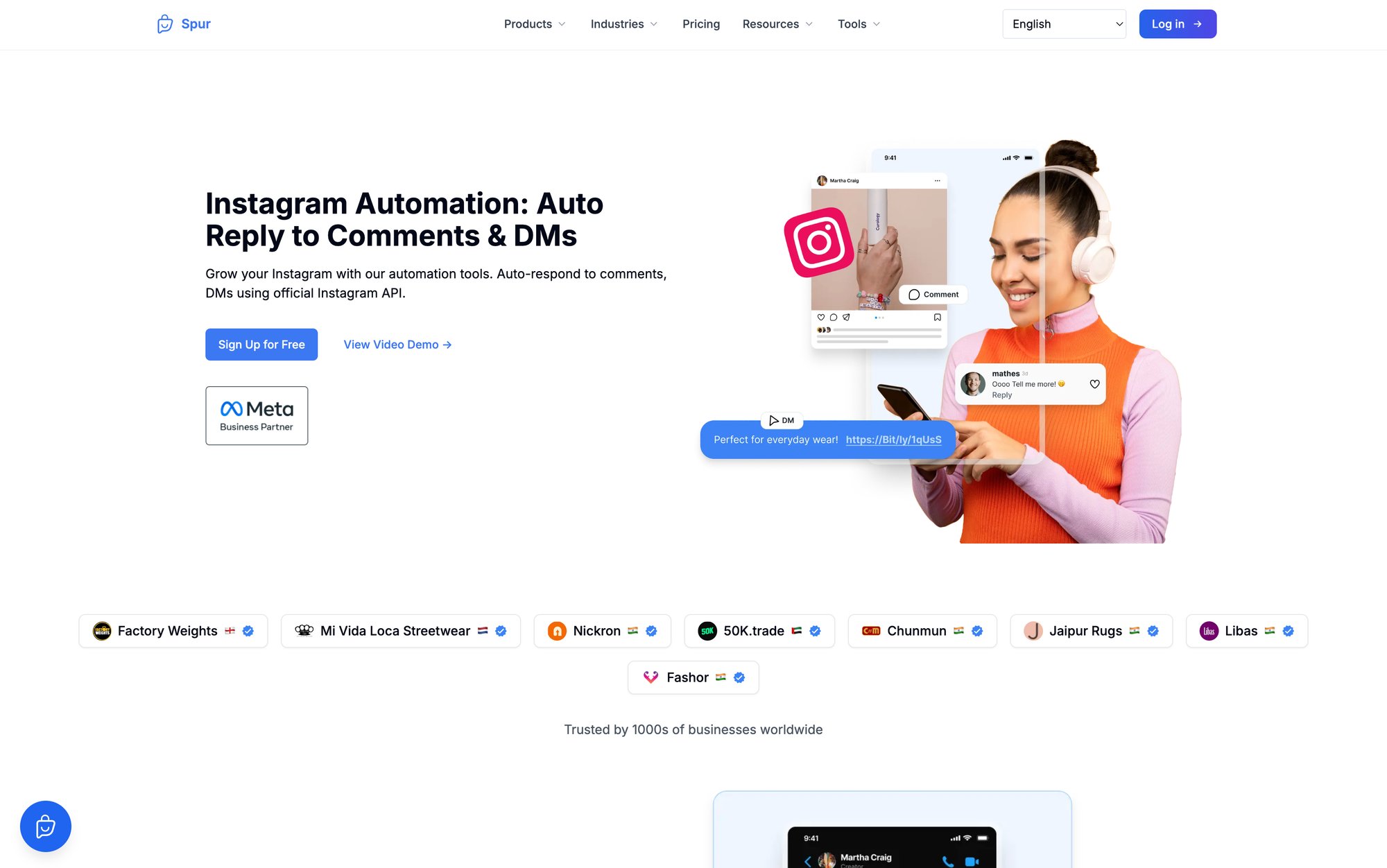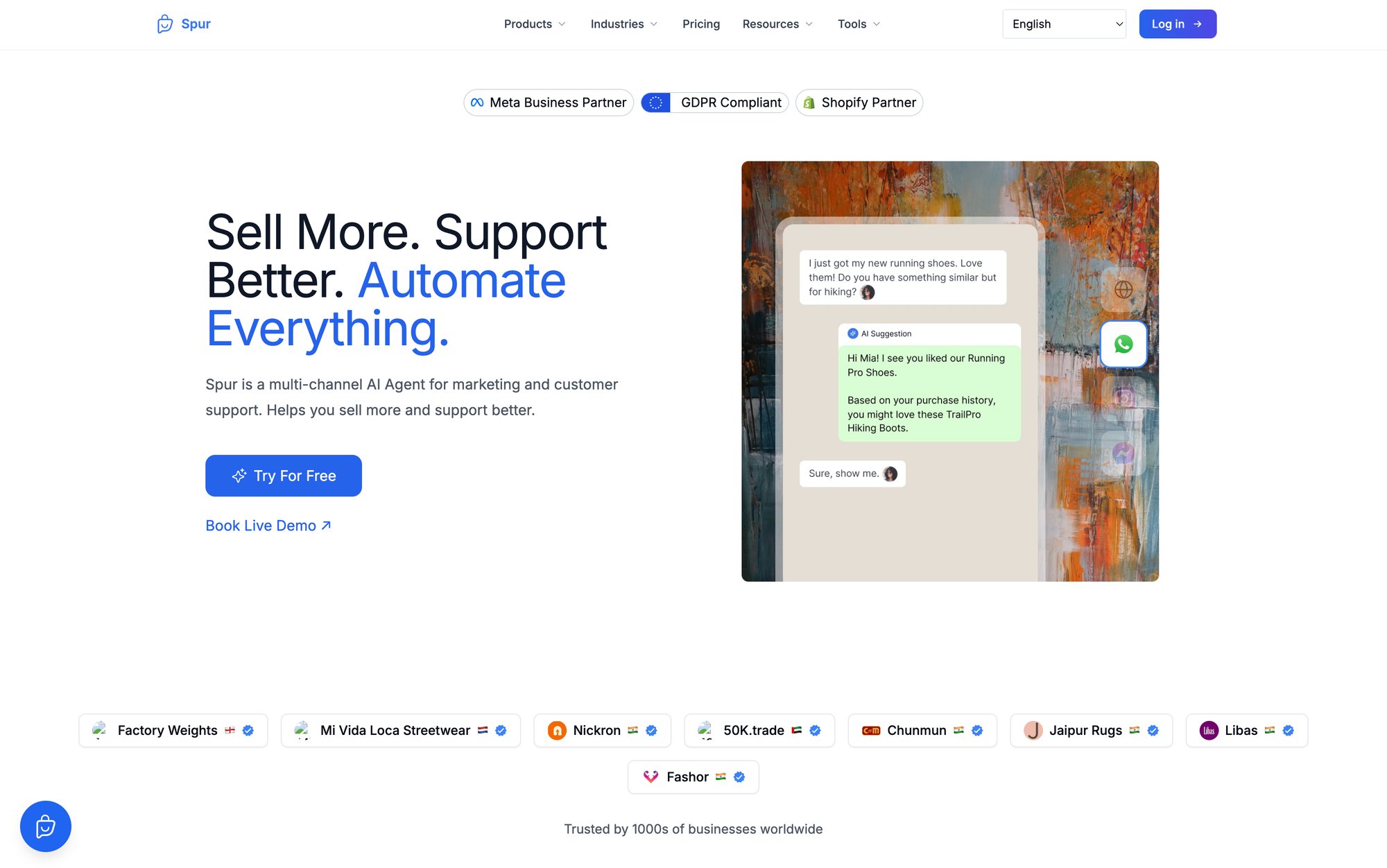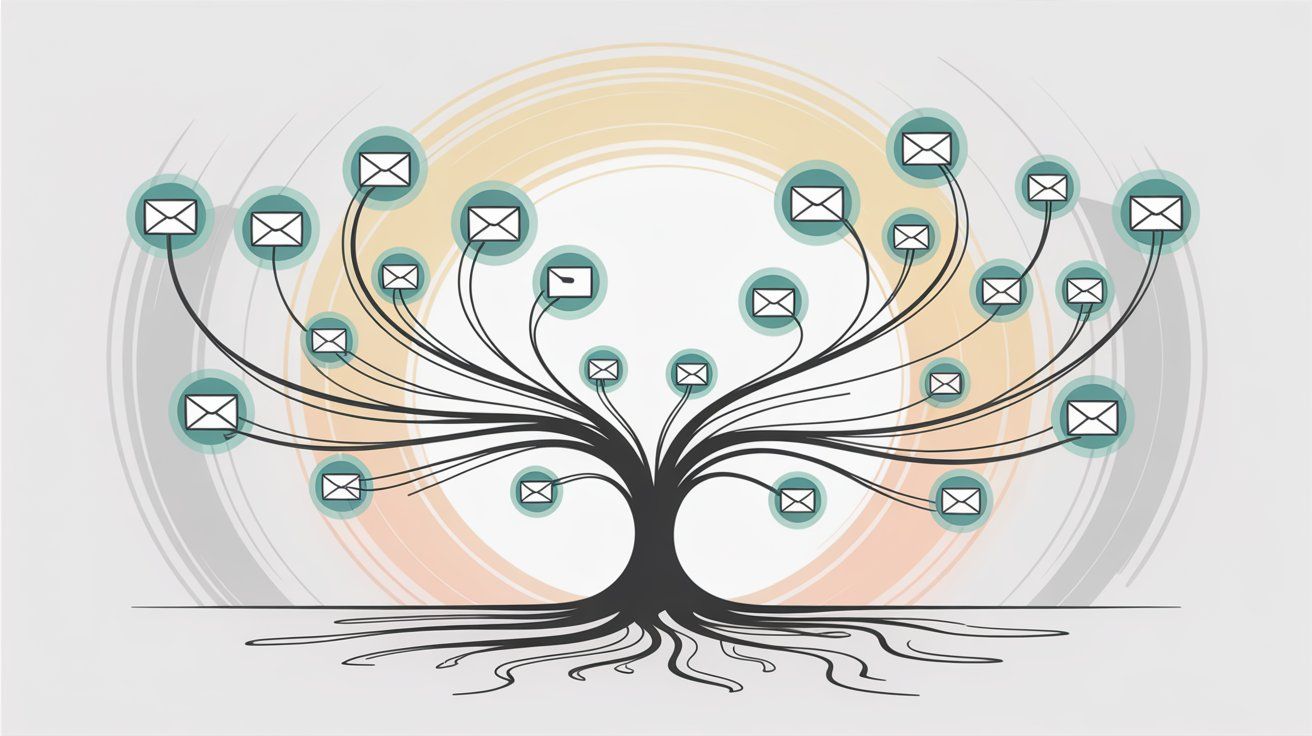
How to Build an Instagram Bot: Complete Guide (2025)
Discuss with AI
Get instant insights and ask questions about this topic with AI assistants.
💡 Pro tip: All options include context about this blog post. Feel free to modify the prompt to ask more specific questions!
TL;DR: Building an Instagram bot is easier than you think. You can either code one using Meta's API or use a no-code platform like Spur to set up automated DM responses, comment triggers, and lead capture in under 30 minutes. The payoff? 24/7 customer engagement, 3x more leads, and support costs cut by 30%. We'll show you exactly how to do it.

Instagram isn't just for scrolling anymore. With over 1.3 billion users and 1 in 2 people discovering new brands on Instagram, it's become a serious business channel. Over 375 million users message businesses on Instagram every month.
Think about that for a second. Millions of potential customers are trying to reach businesses through DMs right now. They're asking about pricing, shipping, product details, and availability. The problem? No human team can handle hundreds of conversations simultaneously while maintaining instant response times.
That's where Instagram bots come in.
A properly built Instagram bot can greet customers instantly, answer common questions, capture leads from comments, and route complex issues to your team. All while you sleep. But (and this is important) we're not talking about the sketchy "auto-follow" bots that violate Instagram's terms. We're talking about legitimate chatbots that use Instagram's official API to help real customers.
This guide will walk you through building an Instagram bot the right way. You'll learn two approaches: coding it yourself for maximum control, or using a no-code platform to get up and running in 30 minutes. We'll cover everything you need to know, from setting up your account to designing conversation flows that actually convert.
First, some terminology. When most people say "Instagram bot," they could mean one of two very different things.
The bad kind: Bots that auto-follow people, spam comments, or fake engagement. These violate Instagram's terms and can absolutely get your account banned.
The good kind: Chatbots that automate responses in your Instagram Direct Messages and interact with comments on your posts. These are completely legal when they use Instagram's official API.
We're focusing entirely on the second type. These chatbots operate through Meta's approved systems, which means they follow all of Instagram's rules. You can use them to respond to DMs, comments, and story mentions in helpful ways without any risk to your account.
What changed: In mid-2021, Meta opened up the Instagram Graph API for messaging to all businesses. Before that, you needed 10,000 followers. Now there's no follower minimum at all. Any Instagram Business or Creator account can use chatbots and automation.
The catch? You need to use official tools. Platforms like Spur, which is an approved Instagram partner, are built on Meta's official API and won't get you in trouble.
Bottom line: Instagram bots are legal, effective, and essential for businesses that take customer engagement seriously. Just stick to the official methods we'll outline here.
You might be thinking, "We manage our DMs just fine manually." Maybe you do right now. But consider what you're missing.
69% of consumers expect a reply from brands within 24 hours, and 16% expect a response within minutes. An Instagram bot responds in seconds, not hours. This matters more than you think.
When someone DMs you at 11 PM asking if you ship to their country, a bot can answer immediately instead of making them wait until morning. By the time you wake up, they might have already bought from a competitor.
Instagram chatbots are available 24/7, which means you're never "closed" for customer inquiries. That alone can be the difference between capturing a sale and losing it.
Instagram bots get interesting here. They can turn casual social media interactions into actual leads.
The traditional approach is putting a "link in bio" and hoping people click it. The problem? Most people don't. It requires them to stop what they're doing, go to your profile, click the link, and then take action. Too much friction. The link-in-bio approach is essentially dead.
Instagram bots let you run "Comment to DM" campaigns instead. You post something valuable (a guide, discount code, or resource) and tell people to comment a specific word. When they do, the bot automatically DMs them with the next step.
The results speak for themselves. Businesses using Comment Automation see 3x more leads and sales compared to the link-in-bio method. One coach collected over 2,000 email leads at an 80% conversion rate by delivering a free guide via an Instagram DM bot. That same coach's landing page only converted at 5%.
The math is simple: interactive chat funnels often convert around 50% of users, while traditional landing pages average only 6%. The bot engages people in the moment of interest, so more of them follow through.

An Instagram bot doesn't just sit in your inbox. It can automatically respond to comments on your posts and reply when someone mentions you in their story.
Think about the last time you commented on a brand's post asking about pricing. If they replied instantly with "Thanks for your comment! Check your DMs for pricing details," you'd probably check those DMs, right?
This kind of instant interaction turns casual scrollers into active conversations. It also makes people feel heard. When someone tags your brand in their story, an immediate "Hey {name}, thanks for the shoutout!" message builds genuine loyalty.
Answering "What's your return policy?" for the 500th time isn't a good use of your team's skills.
Instagram bots can automate answers to frequently asked questions instantly. Companies save around 30% on customer support costs by deploying chatbots. Even if your bot only handles 40% of incoming questions automatically, that could save hundreds of hours per month.
Your human agents can focus on complex issues and VIP customers instead of typing the same response over and over. And customers get faster answers, which improves satisfaction. Win-win.
One person can only handle so many conversations at once. Bots can handle hundreds simultaneously without breaking a sweat.
Got a viral Reel and suddenly 500 people DM'd you in an hour? A bot greets each one instantly. No queue. No frustrated customers waiting.
Plus, bots can be multilingual. Some platforms let you build chatbots in over 100 languages, automatically detecting and replying in Spanish, Hindi, or Portuguese just as easily as English.
Reaching a global audience with personalized responses is finally realistic, even if you're a small team.
Building an Instagram bot isn't complicated, but you do need a few things in place first.
An Instagram Business or Creator Account
The Instagram API only works with professional accounts, not personal profiles. If you haven't switched yet, you can do it in your Instagram app settings for free. There's no follower count requirement anymore.
A Facebook Business Page Linked to Your Instagram
This feels weird if you primarily use Instagram, but it's required. Instagram's API ties into Facebook's systems, so you need a Facebook Page connected to your IG account.
Create a Facebook Page for your business if you don't have one, then link it in your Instagram settings under "Account" and then "Linked Accounts." Make sure you have admin rights to the Facebook Page.
A Developer App (if coding) OR a Chatbot Platform Account (if going no-code)
We'll discuss both approaches in detail, but you'll need one or the other. If you're coding it yourself, you'll register as a Facebook Developer and get API credentials. If you're using a no-code platform like Spur, you just need an account on their platform.
The key is ensuring whatever tool you use is an official Instagram API partner. This guarantees it's approved by Meta and handles permissions correctly. Spur is an official Instagram partner, ensuring secure and compliant automation.

Clear Goals and Content
Before you start building, outline what you want your bot to do:
• List the common questions you get
• Define the prompts you want to respond to
• Specify the actions the bot should take
For example: "If user comments 'PRICE' on Post X, DM them a link to pricing" or "When someone DMs 'help', offer FAQ options."
A little planning on paper goes a long way when you start configuring the bot.
15-30 Minutes of Setup Time
That's honestly all it takes to get a basic bot live with a no-code platform. If you're coding, expect hours to days depending on complexity. Either way, set aside focused time to connect accounts and configure your bot's behavior.
There are two main approaches to creating an Instagram chatbot in 2025:
| Approach | Best For | Complexity | Time Required |
|---|---|---|---|
| Code it yourself using Instagram Graph API | Developers who want maximum control | High (requires API knowledge) | Days to weeks |
| Use a no-code chatbot builder | Everyone else (marketers, business owners) | Low (visual interface) | 15-30 minutes |
We'll cover both. If you're not technical, skip straight to Option 2. If you're curious about how things work under the hood, Option 1 is worth reading.
Building an Instagram bot from scratch means working directly with Meta's Instagram Graph API. This is powerful but complex.
Step 1: Register as a Facebook Developer and Create an App
Go to the Facebook Developers site and create a new app. Add the "Instagram Basic Display" and "Instagram Messaging" products to your app. Meta will issue you an App ID and App Secret.
Step 2: Link Your Instagram Account and Get Permissions
In your developer app dashboard, add your Instagram Business account by logging in and authorizing. Request the necessary permissions for messaging: pages_messaging, instagram_basic, instagram_manage_messages, and instagram_manage_comments.
In Development mode, you can test with your own accounts. For production use, you'll need to submit for App Review so Meta approves your bot's permissions.
Step 3: Generate Access Tokens
Create a System User and generate a long-lived Page Access Token with IG messaging permissions. This token is your "API key" that lets your code act on behalf of your Instagram business account.
Step 4: Set Up Webhooks
Instagram's API works via webhooks. Meta will send an HTTP request to your server whenever there's a new message or event (DM, comment, story mention, etc.).
You need a webhook endpoint URL on a server and configure your Facebook app to send Instagram messaging events to that URL. This requires hosting with an HTTPS URL.

Step 5: Write the Bot Logic
Now the interesting part: coding your bot's brain. Common choices are Python, Node.js, or PHP.
When your endpoint receives a webhook (a JSON payload saying "User X sent a DM saying 'Hello'"), your code needs to decide how to respond. You might have simple if/then logic or integrate NLP.
For example:
• If the message contains "price" or "cost," reply with pricing info
• If a comment on a specific post says "GUIDE," send that user a DM with the guide link
• If you want AI, integrate an NLP service or train a chatbot on your own data
To send a reply, you'll use Instagram Messaging API endpoints. The Facebook Graph API docs provide exact endpoints and JSON formats for sending text, images, quick replies, etc.
Step 6: Test in Sandbox
Use tools like the Graph API Explorer or send test DMs to your connected Instagram account. Check that your webhook receives them and your bot code sends back intended replies.
Facebook also provides an API simulator for messaging events to help test your webhook handling.
Step 7: Submit for Approval
If your bot will be used with real users (not just test accounts), you need to put your app in Live mode. This requires App Review. You'll provide Meta a screencast showing how your bot works and ensuring it complies with policy.
Step 8: Deploy and Monitor
Host your bot code on a reliable server or cloud platform (AWS, Heroku, Firebase) so it runs 24/7. Monitor activity and logs. The Graph API has rate limits, so ensure you handle those. Be prepared for occasional API version updates.
Pros: Complete flexibility, custom AI logic, no monthly fees to a chatbot platform.
Cons: Significant development effort, you're responsible for maintenance and compliance with message window rules, and if something breaks, you fix it.
For most businesses, this is overkill. But if you're a developer or have engineering resources, it's good to know what's possible.
Most businesses will build their Instagram bot using a third-party platform. No coding required.
Step 1: Choose a Chatbot Platform and Sign Up
Research and pick a platform that fits your needs. Spur is purpose-built for Instagram automation with powerful features including Comment-to-DM automation, AI-powered responses, and multi-channel support.
What to look for:
→ Official Instagram integration to ensure smooth connection and policy compliance
→ Features like comment triggers, story replies, keywords, and AI capabilities
→ Ease of use with drag-and-drop flow builders and templates
→ Cost within your budget (many offer free trials or free plans)
We use Spur as our example because we know it best, but the general process is similar across platforms.
Step 2: Connect Your Instagram Account
This is usually well-guided by the platform's interface. Go to Settings or "Add Channel" and choose Instagram. The platform will redirect you to Facebook login to authorize access.
Log in with the Facebook account that is admin of your Facebook Page (which is linked to your IG account). Grant the platform permission to manage your Facebook Page and Instagram messages.
Once done, the platform will list your FB Pages. Select the one linked to your Instagram, then select the Instagram Business account itself. After a moment, you should get confirmation that your IG account is connected and ready. Learn more about connecting Instagram to Shopify if you're running an e-commerce store.
Troubleshooting tip: If you run into issues, double-check that your Instagram is a professional account and linked to a Facebook Page you have admin access to. Also ensure your Facebook account has two-factor authentication enabled (Meta sometimes requires it).
For example, Spur's Instagram automation platform provides a visual interface for setting up Comment-to-DM triggers, story reactions, and AI-powered responses without any coding required:

Step 3: Set Up Your Triggers and Automations
Now for the fun part: telling your bot when to activate and what to do.
Most platforms have an Automation section where you configure triggers:
① Welcome Message / Conversation Starters
Set a general welcome auto-response like "Hi there! 👋 How can we help you today?" with quick-reply buttons for "Track my order" or "Talk to support." This ensures even blank messages get a prompt.
② Keyword Triggers in DMs
Define keywords that trigger specific replies or flows:
• Set "order" or "status" to trigger your order tracking flow
• Set "help" to trigger support FAQs
• Set "newsletter" to send signup info
Set a fallback for unrecognized messages: "Sorry, I'm not sure about that. Type 'menu' to see options."
③ Post Comment Triggers (Comment-to-DM)
This is powerful. Choose a specific Instagram post and set a keyword. When someone comments that word on the post, the bot automatically DMs them.
For example: "Comment WORKOUT to get our free fitness guide." When someone comments "WORKOUT," they immediately get a DM with the guide.
Tip: Make the first DM personal and confirm what they asked for. Like: "Hey {name}, thanks for commenting! You want the workout guide, right? Tap below 👇"
This way it doesn't feel like a robot. It's clearly referencing their request.
④ Story Mention Triggers
If people frequently tag your account in their Stories, set an automation to thank them: "Thanks for mentioning us in your Story, {name}! Here's a 10% off coupon as a thank-you."
This kind of instant acknowledgment turns user-generated content into loyalty.
⑤ Story Reply Triggers
If someone reacts to your Story with an emoji or reply, auto-respond with "Got it, thank you!" or answer a poll response via DM. Learn more about Instagram Stories features like reposting.
⑥ Instagram Ads to DM
If you run Click-to-Instagram DM ads, many platforms let you create a specific ad welcome flow. When the ad triggers a DM, the bot handles the greeting: "Hi! Saw you clicked our ad. How can we help you today?"
This is highly effective for qualifying leads from ads automatically.
Step 4: Design Your Chatbot Messages and Flows
Most platforms offer templates for common flows (FAQ, product recommendation, lead magnet delivery, etc.).
Use a visual flow builder to map out conversation steps. For example:
Use the person's name for personalization. Sound human and friendly, not robotic. Follow chatbot best practices for natural conversations.
Then present Quick Reply buttons or Carousel options. Instead of immediately dropping a link, add a button like "Yes, send me the guide!" and another "What's this about?" for those wanting more info first.
This segments user intent. Those who click "Learn More" get details, while those who click "Get Guide" jump straight to the link.
Branch your flow based on user choices:
• One branch delivers the guide: "Awesome! Here's your free guide: [link]. Let me know how you like it 💪"
• The other branch for "learn more" gives highlights and asks another qualifying question like "Interested in 1-on-1 coaching too?"
Set up FAQ responses using keywords. If someone types "shipping," send your shipping policy. For "pricing," send a brief summary or link.
Create a menu of one-word triggers for common queries. This dramatically reduces repetitive Q&A.
AI-powered replies
Some platforms (including Spur) let you train an AI on your website's FAQ or knowledge base. Upload your website content, FAQs, product catalogs, or help docs. The AI learns from your actual information and uses it to answer questions.
This means your bot is smart from day one, not just after weeks of manual programming. Learn more about training chatbots on your website data.
Example: A user asks, "Hi, I ordered last week and haven't gotten shipping info, can you help?" Your keyword triggers might not catch that, but an AI could respond: "Sure, please provide your order number and I'll check the status for you."
Keep AI responses monitored and set clear limits, but it's great for handling unpredictable questions. Learn more about training ChatGPT on your own data.
When designing messages, keep them concise and friendly. Use media or formatting to your advantage. Instagram bots can send images, GIFs, and product cards.
A clothing boutique bot might send a carousel of images when someone asks "What's new this week?" Visual elements feel rich and engaging.
Step 5: Set Up Integrations (Optional)
Many chatbot platforms integrate with other apps. You might integrate Google Sheets to log leads, Shopify to pull order details, or MailChimp to add email subscribers.
Spur, for example, integrates with e-commerce platforms like Shopify, WooCommerce, Stripe, and Razorpay so you can build "Where's my order?" flows that check actual order status.
While optional, think about what systems you'd like your IG bot to talk to and see if your platform supports it.
Step 6: Test Your Instagram Bot Live
Before unleashing it on followers, test thoroughly. Use a personal Instagram account (not the business account) to trigger the bot.
Comment the trigger word on a test post or send a DM with a keyword. Does it reply quickly? Does the flow make sense? Are personalization tokens working correctly?
Click through quick replies as a user would and ensure it branches correctly. Test unexpected inputs to see your fallback behavior.
Step 7: Launch and Monitor
If testing looks good, turn on those automations. Your bot will work in the background from now on.
In the first weeks, monitor the conversations. Many platforms provide an inbox view where you can see bot-human interactions. Jump in if the bot gets stuck or if a user needs help.
Monitor analytics too: check engagement rates, drop-offs in flows, and click-through rates on links. This helps you refine the bot over time. Learn about measuring social media engagement.
Step 8: Provide a Human Escape Hatch
Make sure users have a clear way to reach a human if needed.
Best practices:
• Program a keyword like "human" or "agent" that immediately notifies a human to take over (and the bot stops responding)
• After a couple of unrecognized responses, the bot can say "Let me get a human to help with that"
• Indicate your live support hours so people know when a human might respond
• Ensure your team monitors Instagram messages through the native app or your platform's unified inbox
Learn more about chatbot-to-human handoff best practices.
By following these steps, you'll have a fully functioning Instagram chatbot on a no-code platform. The heavy lifting (authentication, API calls, etc.) is handled by the platform. You just configure the logic through a nice UI.
Example in action: Imagine you run an online fitness store and coaching service. You create a bot flow for a "Free Workout Guide" offer:
Trigger: Anyone who comments "WORKOUT" on your designated post
Bot DM: "Hey {name}! 💪 Thanks for your interest. Ready to get your free guide?"
• Button 1: "Yes, send me the guide!" (Bot sends link to guide PDF, then asks if they'd like a discount on related products)
• Button 2: "Tell me more first" (Bot explains what's in the guide, then offers it again or an option to ask a question)
Result: Over a week, 100 people comment "WORKOUT." The bot DMs all of them within seconds. 80 click "Yes" and get the guide. 20 click "Tell me more," and 5 of those ask about coaching, which the bot flags for human follow-up.
You just generated 80 new email leads and identified 5 strong prospects for your coaching program. All on autopilot.
Building your bot is step one. To make it effective and beloved by your audience, keep these best practices in mind.
Your bot's messages should sound human. Avoid overly formal or robotic phrasing.
| Avoid | Better |
|---|---|
| "Hello. I am the virtual assistant for XYZ Company. How may I assist you?" | "Hi there 👋! I'm ABC's virtual assistant. How can I help you today?" |
Much warmer. Breaking longer info into a series of chat bubbles also feels more conversational.
The goal is a smooth, helpful chat that doesn't feel like interacting with a machine.
Always greet people by name (your chatbot platform will typically have a {first_name} variable).
If you know their past purchases or location (with permission), use that context. "Glad you liked our post about marathon training!" or "How's the weather in Chicago today?"
Little touches like acknowledging a repeat visitor can delight users. Just be careful not to be creepy. Use data they've willingly given or that's publicly available.
Don't make the conversation only about selling. A great bot session should feel helpful.
Answer the user's question or deliver what you promised before upselling. If they come in asking for support, resolve it or route them to help rather than saying "Check out our new products!" right away.
When you do promote something, frame it as helpful: "By the way, we have a 20% off sale today on the gear you were looking at. Here's the link if you're interested."
Be transparent that the user is chatting with an automated system, at least somewhere early in the interaction.
Many brands say something like "I'm the virtual assistant for XYZ" or "I'm here to help you out instantly!" which implies automation.
And if the bot ever gets confused, a message like "Oops, I'm still learning 😊. Let me get a human to help with that" is far better than spitting out nonsense.
People on Instagram are on mobile and appreciate one-tap replies.
Present buttons for common choices ("Track my order," "See pricing," "Main menu") so users don't have to type exact phrases. This guides the conversation and makes it easier to engage.
Just don't present too many options at once. 3-4 buttons is a good maximum before it gets overwhelming.
Instagram has a 24-hour messaging window policy. You're allowed to message a user freely within 24 hours of their last message to you.
After that, additional messages must be highly relevant or follow certain tags (like post-purchase updates). Most chatbot platforms enforce this automatically.
Design your flows to deliver main value within that initial window. Don't spam users days later unless they've consented.
Treat your bot like a living project. Check the platform's analytics:
• What's the open rate on your initial messages?
• Where do users drop off in a flow?
• How many ask for human help?
Use this info to tweak wording or steps. Maybe you find lots of people typing a question the bot doesn't cover. That's a cue to add a new automation for it.
Continual improvement makes your bot more effective over time. Learn about customer service performance indicators.
Don't set and forget. If your prices, policies, or hours change, update the bot's responses.
Seasonal adjustments too. If a sale ends, make sure the bot isn't still promoting it. Regularly refresh any lead magnets or promotions the bot delivers.
Let people know they can reach you on Instagram and get an instant response.
Promote it on your website ("DM us on Instagram for quick support"), in email newsletters, or through an Instagram Story highlight ("🤖 Chat with our Assistant").
You can use Instagram DM direct links (like https://ig.me/m/yourusername) on your profiles or ads. Clicking these opens a chat with your bot. Learn how to generate Instagram chat links.
The easier you make it for people to start a conversation, the more ROI you'll get.
We've covered two ways to build an Instagram bot: coding it yourself or using a no-code platform. If you're reading this on our blog, you probably know which one we recommend.
Spur is built specifically for businesses that need powerful Instagram automation without the technical headaches:

What makes it different:
Most chatbot platforms give you basic keyword matching or simple FAQ bots. Spur's AI agents can actually take actions. They can track orders, update records, book appointments, or check product availability by connecting to your backend systems.
This is materially different from a static FAQ bot. When a customer asks "Where's my order?" Spur can look up their actual order status and respond with real information, not just a generic "Check your email" message.
Unlike some platforms, Spur lets you train your AI on your own data. Upload your website content, FAQs, product catalogs, or help docs. The AI learns from your actual information and uses it to answer questions.
This means your bot is smart from day one, not just after weeks of manual programming. Learn more about training chatbots on your website data.

Instagram isn't the only place customers reach you. Spur brings WhatsApp, Instagram, Facebook Messenger, and Live Chat into one inbox.
Your team can manage all customer conversations from a single dashboard. No more jumping between apps trying to track who said what where.
Learn more about:
→ Multi-channel marketing automation
Some automation tools are built for developers. Spur is built for business users, marketers, and support teams.
The visual automation builder is intuitive. You can set up comment triggers, story replies, and complex conversation flows without writing a single line of code.
If you need help, Spur's team is there to support you.
Spur is an official Instagram partner, which means the integration is built on Meta's approved API. You won't have any issues with permissions, compliance, or account safety. Learn more about Spur's official Meta approval.
Ready to try it? Spur offers a free trial so you can set up your Instagram bot and see the results for yourself. Most businesses get their first automation running in under 30 minutes.
Check out Spur's pricing to find the plan that fits your needs.
| Question | Answer |
|---|---|
| Will using an Instagram bot get my account banned? | No, not if you use official tools. Bots built on Meta's approved Instagram API (like those from Spur) are completely legal and safe. The bots that get accounts banned are the ones that auto-follow, spam comments, or fake engagement. Chatbots that help real customers are encouraged by Instagram. |
| Do I need coding skills to build an Instagram bot? | Not at all. No-code platforms like Spur let you build fully functional Instagram bots using visual builders and templates. If you can use basic software, you can build a bot. Coding is only required if you want to build from scratch using the Instagram Graph API directly. |
| How much does it cost to run an Instagram bot? | It depends on your approach. If you code it yourself, there's no platform fee (just server hosting costs). No-code platforms have monthly subscriptions. Many offer free plans or free trials to start. Spur's pricing starts with a free trial and scales based on features you need. Most businesses find the ROI from lead generation and support savings far exceeds the cost. |
| Can Instagram bots handle different languages? | Yes. Many platforms support multilingual chatbots in 100+ languages. The bot can detect the language a user is writing in and respond accordingly. This is perfect for reaching global audiences. Spur supports multiple languages for international businesses. |
| What's the difference between a basic chatbot and an AI-powered bot? | Basic chatbots use keyword matching. If someone types "price," it sends a pre-written response. AI-powered bots (like those on Spur) can understand natural language and context. They can handle variations of questions, learn from your knowledge base, and provide more intelligent responses. AI bots are much better at handling unexpected questions. |
| How do I know if my Instagram bot is working well? | Check these metrics: Response rate (Are people engaging?), Completion rate (Do they finish your flows?), Conversion rate (Are conversations leading to desired actions?), Human handoff rate (How often does the bot escalate?). Most platforms provide analytics dashboards to track all of this. Learn about customer service quality assurance. |
| Can bots send promotional messages on Instagram? | Yes, but within rules. You can send promotional content within 24 hours of a user's last message to you. After that window, you need proper opt-in for marketing messages. The bot can also deliver value-based promotions (like sending a discount code when someone asks about pricing), which feels helpful rather than spammy. |
| What happens if the bot doesn't understand a question? | Good bots have fallback responses. They might say "I'm not sure about that. Let me connect you with a human" or "Try typing 'menu' to see options I can help with." Always provide a clear path to human support when the bot can't handle something. |
| How long does it take to set up an Instagram bot? | With a no-code platform, you can have a basic bot running in 15-30 minutes. Building more complex conversation flows with multiple triggers might take a few hours. Coding from scratch using the API takes days to weeks depending on your requirements and technical expertise. |
| Can I use Instagram bots for customer support? | Absolutely. This is one of the best use cases. Bots can handle up to 40% of support inquiries automatically, saving your team hundreds of hours. They're perfect for answering FAQs, checking order status, providing shipping info, or routing complex issues to the right human agent. Learn more about automating customer service and customer service automation best practices. |
| Do Instagram bots work with Instagram ads? | Yes. Click-to-DM ads on Instagram can trigger your bot to start a conversation when someone clicks the ad. This is powerful for lead qualification. The ad brings in interested people, and the bot qualifies them automatically before routing hot leads to your sales team. Learn about Instagram CAPI for lead generation. |
| Can I see what my bot is saying to customers? | Yes. All platforms provide an inbox or conversation history where you can see every interaction the bot has. You can monitor conversations in real-time and jump in to take over if needed. |
| What's the ROI of an Instagram bot? | The ROI varies by business, but the patterns are clear: Businesses report 3x more leads using Comment Automation, support costs drop by about 30%, chat funnels convert at 50% vs 6% for landing pages, and instant response rates improve customer satisfaction and trust. Most businesses see positive ROI within the first month. See our case studies for real-world examples. |
| Can I customize how my bot sounds? | Yes. You control all the messages, tone, and personality. You can make it professional, casual, fun, or whatever matches your brand. Use emojis, GIFs, and your brand's voice to make it feel authentic. |
| What if I want to turn off the bot temporarily? | All platforms let you pause or disable automations whenever you want. You can turn specific triggers on and off, or disable the entire bot with one click. This is useful if you're running a special promotion or need to handle all DMs manually for a period. |
Ready to build your Instagram bot? Start with Spur's free trial and see how automation can transform your Instagram engagement in under 30 minutes.
